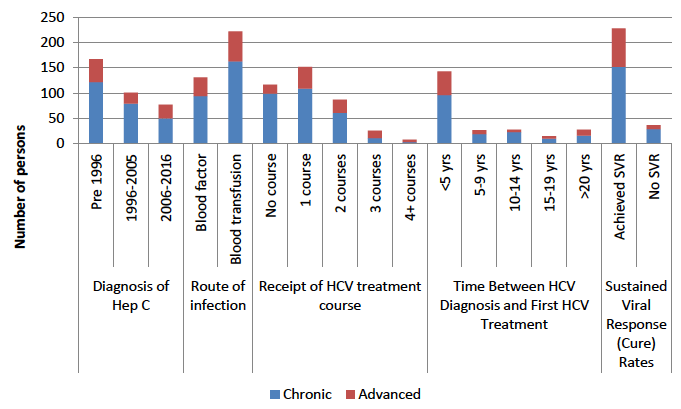Clinical review of the impacts of hepatitis C
Independent clinical review assessed the impacts of chronic hepatitis C infection on health and wellbeing of individuals.
9. Term of Reference 1
Characterise members of the Scottish Infected Blood Support Scheme in terms of their age, gender, blood transfusion/blood factor source of infection, antiviral treatment history and infection status in particular.
9.1 Methods
The Scottish Infected Blood Support Scheme holds a database of people who are receiving awards as a consequence of hepatitis C infection having been acquired through blood factor or blood transfusion.
This database contains limited information on individuals including personal identifiers (name and address), date of birth, gender, application type (advanced HCV, chronic HCV, co-infection with HIV or HIV) and status of beneficiary (primary infectee, secondary infectee or widow/widower/civil partner/long term partner). It also contains the patient’s Community Health Index ( CHI) number. No clinical information concerning hepatitis C treatment and response is held on this database.
Health Protection Scotland ( HPS) presides over databases holding information on all individuals in Scotland having had a diagnosis of hepatitis C infection; a range of data are held and these include limited personal identifiers (e.g. soundex code of surname and first part of postcode), data of birth, gender, diagnosis date, treatment for hepatitis C, response to treatment and route of acquisition of infection (e.g. blood factor, blood transfusion, injecting drug use, etc.); the patient’s CHI number is also held.
For most of the variables, information is reasonably complete and accurate, and certainly sufficient for monitoring and research purposes; the data held at HPS are not used to aid the clinical management of individuals.
To achieve a better understanding of the clinical characteristics of SIBSS beneficiaries – especially from a treatment and treatment response perspective – it was agreed by the SIBSS Advisory Group and the Clinical Review Group that the SIBSS database and the HPS databases should be linked in a standard and approved way which would not compromise patient confidentiality. The linkage process, involving the use of the CHI number, was approved by the NHS’s Public Benefit and Privacy Panel - a panel compromising experts whose job it is to ensure that the purpose of, and processes involving, any such data linkage are legitimate i.e. in the public interest and having no potential to do harm to patients.
The linkage exercise used SIBSS data to September 2017 and does not include additional individuals who have been added between September 2017 and March 2018.
9.2 Results
9.2.1 General
The following analyses apply to chronic HCV and advanced HCV primary infectees. Co-infected individuals were excluded because of the small numbers. For Chronic HCV and for Advanced HCV, 251 and 94 cases, respectively were successfully linked.
9.2.2 Diagnosis of hepatitis C
Chronic HCV: Of the 251, 122 (49%) were diagnosed before 1996, 79 (31%) between 1996 and 2005, and 50 (20%) between 2006 and 2016.
Advanced HCV: Of the 94, 45 (48%) were diagnosed before 1996, 22 (23%) between 1996 and 2005, and 27 (29%) between 2006 and 2016.
9.2.3 Route of HCV acquisition
Chronic HCV: Of the 251, 86 (34%) acquired their HCV through blood factor and 162 (65%) through blood transfusion. Route of transmission was not available for 3 (1%) of Chronic HCV cases.
Advanced HCV: Of the 94, 35 (37%) acquired their HCV through blood factor and 59 (63%) through blood transfusion.
9.2.4 Receipt of a Course or Part-Course (some were not completed due to e.g. adverse effects) of HCV treatment
Chronic HCV: Of the 251, 71 (28%) of those diagnosed had received no course, 109 (43%) one course, 60 (23%) two courses, 10 (4%) three courses, <1% four courses. Of those who had received therapy, 57% had received interferon only, 16% had received a Direct Acting Antiviral agent only and 26% had received both.
Advanced HCV: Of the 94, 10 (11%) of those diagnosed had received no course, 43 (46%) one course, 26 (28%) two courses, 10 (11%) three courses, 5 (5%) four courses. Of those who had received therapy, 37% had received interferon only, 21% had received a Direct Acting Antiviral agent only and 42% had received both.
9.2.5 Time between HCV Antibody Positive Diagnosis and First HCV Treatment
Chronic HCV: Of the 180 treated individuals, 96 (59%) took less than five years, 19 (12%) took five to nine years, 23 (14%) took 10 to 14 years, 10 (6%) took 15 to 19 years, and 16 (10%) took 20 plus years. Time to first treatment was not available for 16 cases.
Advanced HCV: Of the 84 treated individuals, 47 (60%) took less than five years, 8 (10%) took five to nine years, 5 (8%) took 10 to 14 years, 5 (6%) took 15 to 19 years, and 12 (15%) took 20 plus years. Time to first treatment was not available for 6 cases.
9.2.6 Sustained Viral Response ( SVR) Rates (i.e. sustained clearance of virus from the blood)
Chronic HCV: Of the 180 treated individuals, 152 (84%) had achieved SVR
Advanced HCV: Of the 84 treated individuals, 76 (90%) had achieved SVR
Figure 1: Summary of linkage between SIBSS and HCV diagnoses and clinical databases

Contact
There is a problem
Thanks for your feedback